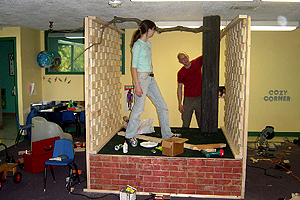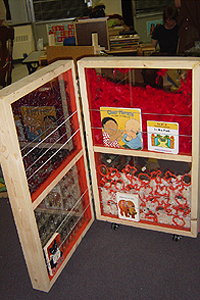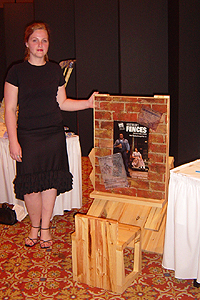Material Exchange collective saves objects from obsolescence
By Jennifer CarnigNews Office
 M.F.A. students in the Department of Visual Arts created this reading loft on a six-foot by six-foot platform. It was built for one of the classrooms at the Chicago Child Care Society. | |
Sara Black and John Preus have taken recycling to a whole new level. The pair has turned their M.F.A.s from the Department of Visual Arts into an artist collective. Together they transform goods that cultural institutions discard—sets from plays or leftovers from art exhibitions—imbuing these materials with new life in a number of ways.
The project, called Material Exchange, aims to bridge the artists’ interests in fine art, design and environmental studies, said Black, who will earn her degree at the end of the Spring Quarter.
“There is a general philosophical underpinning that motivates us, and it’s more than just environmental justice,’ ” she explained. “We’re interested in the way materials move through the world, how the value of a thing shifts in varying contexts and why our culture allows material obsolescence to occur so quickly.”
The goal is to get people to question the label “trash” and ask why some things become trash, adds Preus, who earned his M.F.A. in Visual Arts in 2005.
“Objects and materials have a history that effectively ends when they enter the landfill. We are certainly interested in re-imagining and reusing these materials for environmental and social reasons, but also as a way to investigate a particular set of questions that revolve around surplus and entropy. What a thing is includes the history of its fabrication, and the functions and stories that keep it alive as a vital element in the world,” he said.
Less than a year old, Material Exchange grew out of an internship Black had done last summer at the Smart Museum of Art. The Austrian artist collective WochenKlausur held a three-week residency at the Smart as part of the show “Beyond Green: Toward a Sustainable Art,” and with it they demonstrated their ability to make useful objects from waste created by the museum.
Black and Preus worked with the artists to create a table and set of stools for Deborah’s Place, a Chicago women’s shelter. The idea really clicked with Black, who earned a B.F.A. in sculpture and a B.A. in environmental studies.
 Kristi Ahlstrom built these moveable bookshelves with encased items for a small library at the Chicago Child Care Society. Ahlstrom also proposed a new reader-friendly design for the entire room. | |
Preus, who worked full-time as a furniture maker before he went back to school, was similarly enthused.
As volunteers with Wochenklausur, Black and Preus helped create two databases: one of Chicago-area cultural organizations that generate leftover materials, and another of charitable organizations in need of goods such as desks, chairs and bookshelves.
To get the furniture made, Black and Preus took their project out to local art schools. The two have worked with instructors at Harrington College of Design and the Illinois Institute of Technology where, because of their outreach, classes on surplus-inspired design were taught in the fall and spring.
Isabella Gould, an architect and professor at IIT, taught the class “Beyond Surplus,” which was inspired by Black and Preus and based on a syllabus the two Chicago students wrote.
Black and Preus first connected Gould’s design class with Court Theatre, where Gould, Black, Preus and five design students filled a Ryder truck with materials leftover from the $8,000 set of the August Wilson play “Fences.”
Black and Preus then introduced the class to the Chicago Child Care Society, a Hyde Park-based child-welfare service organization that was in need of a reading loft and seats and shelves for a library. Black and Preus took the IIT students to the center to see what it looked like, meet the recipients and get a feel for what all they would need. Then Gould began working with the young designers.
“It was a very profound experience for all the students,” Gould said of the class, a mix of graduate and undergraduate students. “It was really intense for everybody, and I think in the end they really learned to look at trash with different eyes. They got very interested in sustainable ideas and designing with a sustainable agenda, and I think it changed their perception of design and the materials you use Ð how we make objects, what are they made out of and how much time it takes to return them to a natural cycle. I think they really learned how much we as designers can do for society.”
 Trudy Watt sold her “Unbroken Chair” for $400 at the Chicago Child Care Society’s annual auction “Take a Seat for Children,” in May at the Windham Hotel. | |
Black and Preus regularly attended the lectures and shop time for the class, Gould said. “They’re amazing. They were there cutting, drilling and building with us all along,” she said. “I really think they’re going to make big things happen.”
Material Exchange already has a summer course planned for the Art Institute of Chicago. But their next project is a bit more close to home and close to their own degrees.
Black and Preus also create their own art from discarded goods. As Material Exchange they will build an installation together for the Department of Visual Art’s year-end M.F.A. student exhibition. This year’s show, called “The Space Between,” opens with a reception from 5 to 8 p.m. on Thursday, June 8, on the mezzanine level of the Del Prado Building (the former home of the Hyde Park Art Center), 5307 S. Hyde Park Blvd. The free exhibition will remain open from noon to 6 p.m. Fridays through Sundays until Sunday, June 18.
In addition to Material Exchange’s installation, seven other students will debut their work, including photography, performance art, painting, drawing and sculpture.
“The opportunity is really exciting and energizing,” said Preus. “It’s the basic law of the universe that everything is always changing. But maybe we can get some people’s minds to change, too, and get them to think about and redefine what garbage really is. We want to demonstrate how much useful material is prematurely discarded, and offered it up as a design challenge to try and revive what someone else has given up on.”
![[Chronicle]](/images/sidebar_header_oct06.gif)